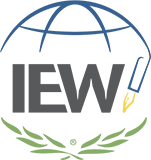
“I hear and I forget; I see and I remember; I write and I understand.” This axiom is often quoted in the world of education. Writing within content areas helps students build understanding. Andrew Pudewa has long taught that writing should be done within subjects that students are already learning. However, it is time consuming to locate sources, plan lessons, and design exercises and activities that teach Structure and Style®. IEW’s theme-based writing lessons come ready-made with all this and are designed to work well in all classrooms, including those with mixed abilities and levels of IEW experience. IEW courses employ spiral learning so students practice concepts previously learned while they learn new concepts. In a recent co-op class for middle school students, I taught Modern World History-Based Writing Lessons. This course begins with Gutenberg’s printing press and ends with the Cold War. It is an excellent book to pair with world history studies. If you’ve wondered how theme-based writing lessons work or what it is like to plan and teach a class using these courses, enjoy a peek into the process as we look at what it is like to teach through a theme-based lesson.
Because the lessons are predictable but also flexible, planning a class using Modern World History-Based Writing Lessons was simple for me. Theme-based courses assume that teachers have viewed or have access to the Teaching Writing: Structure and Style teacher-training seminar. Lessons in theme-based teacher manuals include a note about which training video to watch before teaching a new unit.
Theme-based courses include approximately thirty lessons. While most academic years follow a thirty-six-week schedule, finishing all the lessons in a course is not always a reality. Having fewer than thirty-six lessons in these courses allows for interruptions, more time for longer lessons, and perhaps even a celebration at the end of class. The scope and sequence in the front of the book shows what Structure and Style concepts are being taught. With a class that is less than thirty weeks, you should choose which lessons to focus on. In planning my class, I included lessons that introduced new structure or new style. That meant I left out a few of the later lessons of some units. I encouraged parents to complete those lessons at home during breaks. The clear schedule and sequence of instruction allow for easy planning and flexibility for instructors.
The theme-based courses are designed to be used in a variety of classroom settings. Each lesson includes an Assignment Schedule that can be applied no matter how many days per week you meet. Since my class met once a week, we always covered the first day’s tasks, which included reading the source text(s) or prompt and writing the key word outline (KWO). I wrote on lined easel paper so that we could keep KWOs from week to week. My students had a mix of abilities and experience, so whenever I could, I used the Simplified Source Texts for the KWO. I wrote the class KWO on the pad and then snapped a picture on my phone to send in my weekly email. Keeping all students engaged in the KWO process is important. Even if students are adept at outlining, they can provide ideas for those who are still learning.
Along with note-taking in class, we also practiced stylistic techniques. After brainstorming for style, the students took home a list of possible dress-ups and sentence openers to add to their papers each week. These lists were also recorded on the lined easel paper so that we could look back at them. Because of time limitations the vocabulary and stylistic practice exercises that are typically scheduled on Day 2 in the Assignment Schedule were completed at home. This allowed students to work with their parents and review what we had learned in class. If you are teaching a class that meets more than once a week, the vocabulary and stylistic practice exercises are ideal activities for your second lesson day. It allows you to review the content of the lesson while teaching or practicing style.
Exercises and assignments in theme-based courses are clearly explained so that parents can assist their children at home with any work that is not completed in class. My students completed rough drafts and final drafts at home. The Assignment Schedule typically schedules writing drafts for Days 3 and 4. Parents should edit for basic spelling and punctuation as well as check the student’s paper against the checklist to make sure it is complete. EZ+1 is easily applied. For students who need the checklist adjusted, the reproducible checklists allow you or the parent to simply cross out a requirement. If you have the Premium Membership, the theme-based lesson checklists are available and can be customized using the Checklist Generator™. Many of these lesson checklists are also included in IEW® Gradebook, which you can use if your students submit electronically.
Clearly laid out schedules and sequential lessons that build on concepts previously learned make planning a class using the theme-based writing lessons simple. Because the lessons include everything you need to teach a class, preparation is minimal. Additionally, the theme-based lessons provide support for parents who are helping their students at home. My favorite reason to use the theme-based writing lessons is that the students are writing within content areas, which reinforces the idea that writing helps them learn.
by Danielle Olander
